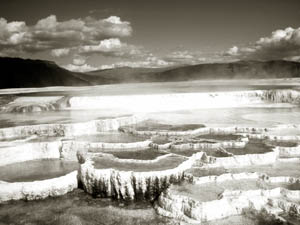|
observer |
|
|
|
|
|
OTHER LINKS |

|

|

|
|
|
|
|
"I'll give you enough details," he added. "All right," I said, sitting beside the spring, happy that I was getting an exclusive interview.
Q: Well, Mr. Hot Spring, can you tell me something about yourself?
A: I'm a hot spring or a hydrothermal spring, as I'm more formally known. I'm the place where warm or hot ground water comes up, from the Earth. The temperature around me is significantly higher than the Earth's normal temperature.
Q: How does the water become hot?
A: Water is warmed by geothermal heat, which is the heat generated by the heat sources within the planet. Generally, the temperature of the rocks within the Earth increases with depth. So, if water touches those rocks, water becomes hot.
Q: Is it true, that areas where hot springs are situated are volcanic positive?
|
|
A: That depends. In the previous answer, I told you how water becomes hot in a non-volcanic area. In a volcanic area, water becomes hot when it touches the magma (molten rock). This high temperature is enough to make the water boil or become superheated.
Q: Are there any special ways through which hot water comes out into the surface?
A: Yes. There are three ways. If the water becomes very hot, it builds steam pressure and comes out like a jet. This is called a geyser. If the water reaches the surface in the form of steam, it is called a fumarole, and if the water comes out mixed with mud and clay, it is called a mud pot.
Q: All right Mr. Hot Spring, can you tell me what benefits you provide us?
A: Heated water can hold more dissolved solids. So, hot and warm springs often contain a very high mineral composition. It contains everything from simple calcium to lithium and even radium.
Because of this, it is scientifically proven that hot springs have high medical value. That's why hot springs are famous tourist destinations.
Q: How is life in a hot spring?
A: There are bacteria who live in springs. For some bacteria, 75 degrees celsius is still cool. Species of Aquitex can live in water as hot as 95 degrees celsius.
The sulphur smell within us is caused by the anaerobic bacteria, which don't need air to live. Warm water also allows an abundance of algae to live.
Plants like watercress, reptiles like garter snakes and amphibians like long-toed salamanders also survive in hot springs.
Q: Please tell me about your famous relatives?
A: In Sri Lanka, you find hot springs at Kinniya, Trincomalee, Madunagala and Mahaoya, where I also reside. There are many others around the world as well, such as, in New Zealand and Iceland. Some of the more famous hot pools in New Zealand are Maruia, Rotorus and Welcome Flat.
The world's largest yielding hot spring is Deildartunguhver. Hot springs are found especially in the highlands. Many areas with hot springs are very hot with steam coming out of the ground. Some have bunds built around them.
Q: Do you have any advice for children?
A: Yes, of course! The hot springs in volcanic areas are often at or near boiling point. People have been seriously burned and even killed by accidentally or intentionally entering these springs. So, you must be really careful. You must make sure the temperature is bearable before you try to have a bath.
"Thank you very much Mr. Hot Spring, that was very informative. Hope to see you again,"."You are welcome, miss," he said with a smile. I continued on my journey thinking what would happen if all the other geographical attractions started to speak!











